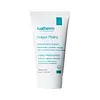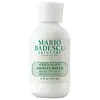What's inside
What's inside
 Key Ingredients
Key Ingredients

 Benefits
Benefits

 Concerns
Concerns

 Ingredients Side-by-side
Ingredients Side-by-side

Water
Skin ConditioningHydrogenated Polyisobutene
EmollientGlycerin
HumectantEthylhexyl Stearate
EmollientPropanediol
SolventCetyl Alcohol
EmollientButyrospermum Parkii Butter
Skin ConditioningSimmondsia Chinensis Seed Oil
EmollientCyclopentasiloxane
EmollientMethyl Methacrylate Crosspolymer
Dimethicone
EmollientCyclohexasiloxane
EmollientGlyceryl Stearate
EmollientPEG-100 Stearate
Cera Alba
EmollientSodium Benzoate
MaskingParaffinum Liquidum
EmollientGlyceryl Acrylate/Acrylic Acid Copolymer
HumectantAcrylates/C10-30 Alkyl Acrylate Crosspolymer
Emulsion StabilisingBisabolol
MaskingCarbomer
Emulsion StabilisingChlorphenesin
AntimicrobialPhenoxyethanol
PreservativeTocopheryl Acetate
AntioxidantChlorhexidine Digluconate
AntimicrobialSilica
AbrasiveViola Tricolor Extract
EmollientSodium Hydroxide
BufferingEthylhexylglycerin
Skin ConditioningTocopherol
AntioxidantWater, Hydrogenated Polyisobutene, Glycerin, Ethylhexyl Stearate, Propanediol, Cetyl Alcohol, Butyrospermum Parkii Butter, Simmondsia Chinensis Seed Oil, Cyclopentasiloxane, Methyl Methacrylate Crosspolymer, Dimethicone, Cyclohexasiloxane, Glyceryl Stearate, PEG-100 Stearate, Cera Alba, Sodium Benzoate, Paraffinum Liquidum, Glyceryl Acrylate/Acrylic Acid Copolymer, Acrylates/C10-30 Alkyl Acrylate Crosspolymer, Bisabolol, Carbomer, Chlorphenesin, Phenoxyethanol, Tocopheryl Acetate, Chlorhexidine Digluconate, Silica, Viola Tricolor Extract, Sodium Hydroxide, Ethylhexylglycerin, Tocopherol
Butyl Methoxydibenzoylmethane 2%
UV AbsorberEthylhexyl Methoxycinnamate 7.5%
UV AbsorberBenzophenone-3 5%
UV AbsorberWater
Skin ConditioningHydrogenated Polyisobutene
EmollientGossypium Herbaceum Seed Oil
Skin ConditioningEthylhexyl Methoxycrylene
Skin ConditioningStearic Acid
CleansingCetyl Alcohol
EmollientSoluble Collagen
HumectantGlyceryl Stearate
EmollientPEG-100 Stearate
Acrylates/C10-30 Alkyl Acrylate Crosspolymer
Emulsion StabilisingSodium Hydroxide
BufferingLeuconostoc/Radish Root Ferment Filtrate
AntimicrobialPhenoxyethanol
PreservativeCaprylyl Glycol
EmollientHexylene Glycol
EmulsifyingButyl Methoxydibenzoylmethane 2%, Ethylhexyl Methoxycinnamate 7.5%, Benzophenone-3 5%, Water, Hydrogenated Polyisobutene, Gossypium Herbaceum Seed Oil, Ethylhexyl Methoxycrylene, Stearic Acid, Cetyl Alcohol, Soluble Collagen, Glyceryl Stearate, PEG-100 Stearate, Acrylates/C10-30 Alkyl Acrylate Crosspolymer, Sodium Hydroxide, Leuconostoc/Radish Root Ferment Filtrate, Phenoxyethanol, Caprylyl Glycol, Hexylene Glycol
Ingredients Explained
These ingredients are found in both products.
Ingredients higher up in an ingredient list are typically present in a larger amount.
Acrylates/C10-30 Alkyl Acrylate Crosspolymer is a synthetic polymer. It is used to thicken and improve the texture of products. Due to its properties, it can prevent water and oil ingredients from separating.
Cetyl Alcohol is a fatty alcohol. Fatty Alcohols are most often used as an emollient or to thicken a product.
Its main roles are:
Though it has "alcohol" in the name, it is not related to denatured alcohol or ethyl alcohol.
The FDA allows products labeled "alcohol-free" to have fatty alcohols.
Learn more about Cetyl AlcoholGlyceryl Stearate is a mix of glycerin and stearic acid.
It is used to stabilize the mixing of water and oil ingredients. By preventing these ingredients from separating, it can help elongate shelf life. It can also help thicken the product's texture.
As an emollient, it helps soften skin and supports barrier-replenishing ingredients.
In cosmetics, Glyceryl Stearate is often made from vegetable oils or synthetically produced.
This ingredient may not be fungal-acne safe
Fun fact: The human body also creates Glyceryl Stearate naturally.
Learn more about Glyceryl StearateHydrogenated Polyisobutene is a synthetic polymer. Polymers are compounds with high molecular weight. Hydrogenated Polyisobutene is an emollient and texture enhancer.
In one study, Hydrogenated Polyisobutene showed better skin hydration levels than Caprylic/Capric Triglyceride. As an emollient, it helps keep your skin soft and hydrated by trapping moisture in.
Hydrogenated Polyisobutene is often used as a mineral oil replacement.
Learn more about Hydrogenated PolyisobutenePeg-100 Stearate is an emollient and emulsifier. As an emollient, it helps keep skin soft by trapping moisture in. On the other hand, emulsifiers help prevent oil and water from separating in a product.
PEGS are a hydrophilic polyether compound . There are 100 ethylene oxide monomers in Peg-100 Stearate. Peg-100 Stearate is polyethylene glycol ester of stearic acid.
Phenoxyethanol is a preservative that has germicide, antimicrobial, and aromatic properties. Studies show that phenoxyethanol can prevent microbial growth. By itself, it has a scent that is similar to that of a rose.
It's often used in formulations along with Caprylyl Glycol to preserve the shelf life of products.
Sodium Hydroxide is also known as lye or caustic soda. It is used to adjust the pH of products; many ingredients require a specific pH to be effective.
In small amounts, sodium hydroxide is considered safe to use. However, large amounts may cause chemical burns due to its high alkaline.
Your skin has a natural pH and acid mantle. This acid mantle helps prevent harmful bacteria from breaking through. The acid mantle also helps keep your skin hydrated.
"Alkaline" refers to a high pH level. A low pH level would be considered acidic.
Learn more about Sodium HydroxideWater. It's the most common cosmetic ingredient of all. You'll usually see it at the top of ingredient lists, meaning that it makes up the largest part of the product.
So why is it so popular? Water most often acts as a solvent - this means that it helps dissolve other ingredients into the formulation.
You'll also recognize water as that liquid we all need to stay alive. If you see this, drink a glass of water. Stay hydrated!
Learn more about Water